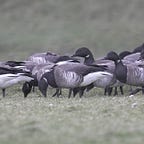SEASON OF MYTHS AND MELLOW FRUITFULNESS
Autumn’s influx of Blackbirds from overseas is well underway. Pick a small Irish island that can be walked from end to end and you will find that, during most mornings in October, a few Blackbirds will arrive. The migration continues into November. When pools of cold weather settle over Scandinavia, the trickle of immigrants becomes a flood. Little wonder. Most of Scandinavia’s Blackbirds depart when winter bites. Ireland and Britain can hold the bulk of the populations from countries like Norway, Sweden and even Finland. Although adults and young are involved in these movements, adult males are torn between staying closer to home rather than flying west. Why? Because they do not want to vacate a breeding territory or be so far away from it that they risk being gazumped by an interloper when they attempt to reoccupy home turf the following spring.
Sifting through the turnover of immigrants shows if a male is young or old. Males hatched in 2018 bear hallmarks of youth. Perhaps surprisingly, no two young males are exactly the same. Adult males, on the other hand, seldom differ. Not only is their plumage uniformly black but their bill will be pure breakfast-juice orange, as will the ring of colour around the eye. Until after Christmas, no young male will match the uniform orange-yellow bill and bright eye-ring. Young males — and young females — begin life with a dark brown bill.
Young males, as they develop, gradually acquire the bill colour of their father. But the process is variable and throws up dark-billed individuals — especially during early autumn — and others whose bill is a mucky yellow at the base or a mixture of black and yellow. The same transition affects the eye-ring, although its change is to brightness from a uniformly dull start. Hence, these days, it is feasible to pick out a black-bodied Blackbird and, beginning from the standpoint that it is a male, look at the bill and eye-ring and — unless they are clean, bright and gold — know that the individual is a young male.
There is another criterion that confirms age. Although the bill and eye-ring acquire adult colours through, I assume, hormonal activity, feathers do not. When juvenile, a young male Blackbird was clothed in speckled plumage. In that garb it was virtually indistinguishable from a juvenile female. That was back in May or June. During July, all of the new generation moulted plumage. For the first time, the new kit earmarked them as either male or female. However, not all of their juvenile plumage was upgraded. The tail, the flight feathers of the wing and some of the larger feathers (called coverts) cloaking the flight feathers, are kept until the bird is roughly one year old.
How come? The reason is because these are the largest feathers on a bird and they are costly to grow. The rest of the plumage consists of smaller feathers that are easier to replace. Moult timing is a fairly complicated subject. You do not need to know more. But you do need to know that the flight feathers (and tail) on a young male Blackbird will be brown, not black. The explanation is a no-brainer. These feathers were grown by the young male in the nest and they will not be shed and replaced with all-black ‘daddy feathers’ until next summer.
In summary: brown flight feathers (the long feathers that, at rest, form the wing-point) indicate a young male. To boot, the bill on a young male can be anywhere between ‘blackish’ and grubby yellow. Equally, the eye-ring will be anything but bright. Remember, after Christmas, the colours of the bill and eye-ring rapidly start to change. Let’s correct a myth. Simply because many immigrant Blackbirds reach Ireland and Britain from Scandinavia and, among them, a sizeable proportion of young males are dark-billed, this does not mean that there is such a thing as a ‘northern’ Blackbird that happens to be distinguishable from Irish and British stock through being dark-billed. This is gibberish. During autumn, any young male Blackbird can look like this. I call them ‘black princes’. That seems to put them on the pedestal they deserve.
